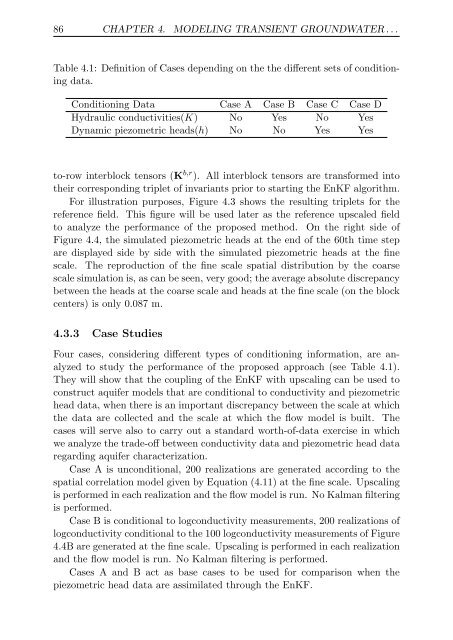Upscaling and Inverse Modeling of Groundwater Flow and Mass ...
Upscaling and Inverse Modeling of Groundwater Flow and Mass ...
Upscaling and Inverse Modeling of Groundwater Flow and Mass ...
Create successful ePaper yourself
Turn your PDF publications into a flip-book with our unique Google optimized e-Paper software.
86 CHAPTER 4. MODELING TRANSIENT GROUNDWATER . . .<br />
Table 4.1: Definition <strong>of</strong> Cases depending on the the different sets <strong>of</strong> conditioning<br />
data.<br />
Conditioning Data Case A Case B Case C Case D<br />
Hydraulic conductivities(K) No Yes No Yes<br />
Dynamic piezometric heads(h) No No Yes Yes<br />
to-row interblock tensors (K b,r ). All interblock tensors are transformed into<br />
their corresponding triplet <strong>of</strong> invariants prior to starting the EnKF algorithm.<br />
For illustration purposes, Figure 4.3 shows the resulting triplets for the<br />
reference field. This figure will be used later as the reference upscaled field<br />
to analyze the performance <strong>of</strong> the proposed method. On the right side <strong>of</strong><br />
Figure 4.4, the simulated piezometric heads at the end <strong>of</strong> the 60th time step<br />
are displayed side by side with the simulated piezometric heads at the fine<br />
scale. The reproduction <strong>of</strong> the fine scale spatial distribution by the coarse<br />
scale simulation is, as can be seen, very good; the average absolute discrepancy<br />
between the heads at the coarse scale <strong>and</strong> heads at the fine scale (on the block<br />
centers) is only 0.087 m.<br />
4.3.3 Case Studies<br />
Four cases, considering different types <strong>of</strong> conditioning information, are analyzed<br />
to study the performance <strong>of</strong> the proposed approach (see Table 4.1).<br />
They will show that the coupling <strong>of</strong> the EnKF with upscaling can be used to<br />
construct aquifer models that are conditional to conductivity <strong>and</strong> piezometric<br />
head data, when there is an important discrepancy between the scale at which<br />
the data are collected <strong>and</strong> the scale at which the flow model is built. The<br />
cases will serve also to carry out a st<strong>and</strong>ard worth-<strong>of</strong>-data exercise in which<br />
we analyze the trade-<strong>of</strong>f between conductivity data <strong>and</strong> piezometric head data<br />
regarding aquifer characterization.<br />
Case A is unconditional, 200 realizations are generated according to the<br />
spatial correlation model given by Equation (4.11) at the fine scale. <strong>Upscaling</strong><br />
is performed in each realization <strong>and</strong> the flow model is run. No Kalman filtering<br />
is performed.<br />
Case B is conditional to logconductivity measurements, 200 realizations <strong>of</strong><br />
logconductivity conditional to the 100 logconductivity measurements <strong>of</strong> Figure<br />
4.4B are generated at the fine scale. <strong>Upscaling</strong> is performed in each realization<br />
<strong>and</strong> the flow model is run. No Kalman filtering is performed.<br />
Cases A <strong>and</strong> B act as base cases to be used for comparison when the<br />
piezometric head data are assimilated through the EnKF.


